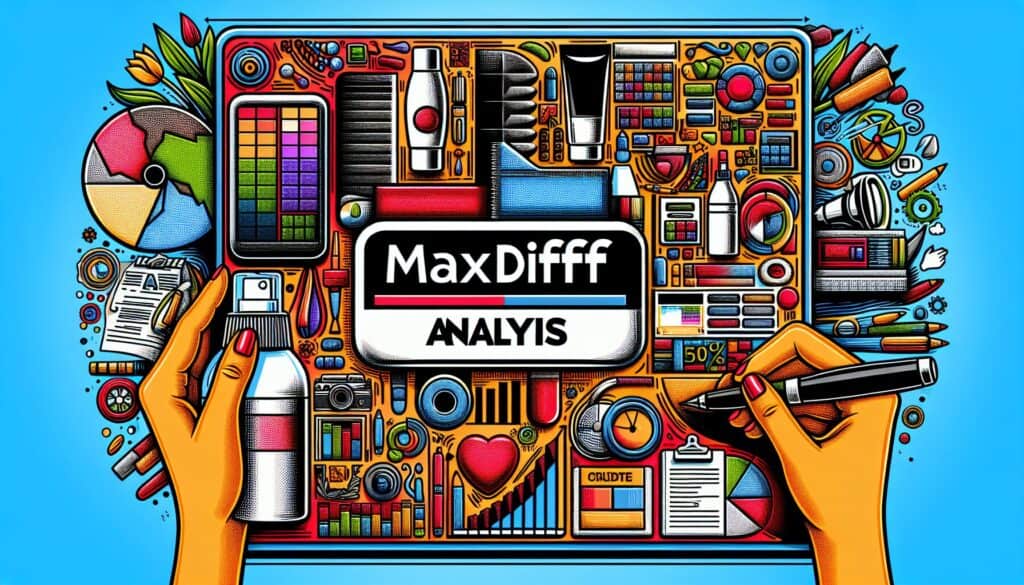A market research technique used to measure the relative preference or importance of a set of items (e.g., product features, brand names, تسويق messages).
- المنهجيات: العملاء والتسويق, الاقتصاد, تصميم المنتج
MaxDiff Analysis (Maximum Difference Scaling)

MaxDiff Analysis (Maximum Difference Scaling)
- المنهجية الرشيقة, تجربة العملاء, التفكير التصميمي, أبحاث السوق, تطوير المنتجات, إدارة المنتجات, التحليل الإحصائي, تجربة المستخدم (UX), واجهة المستخدم (UI)
الهدف:
كيفية استخدامه:
- Respondents are shown subsets of items and asked to indicate which item is the best/most important and which is the worst/least important from the subset. This is repeated with different subsets.
الايجابيات
- Provides a more discriminating measure of importance than simple rating scales; easier for respondents than full ranking of many items; produces interval-scale scores.
سلبيات
- Can be more cognitively demanding for respondents than simple rating scales; requires specialized software for design and analysis; selection of items to test is critical.
الفئات:
- العملاء والتسويق
الأفضل لـ
- Measuring the relative importance or preference for multiple items (e.g., features, benefits, messages) more effectively than rating scales.
MaxDiff Analysis, or Maximum Difference Scaling, is an advanced methodology particularly valuable in market research and product development across various industries such as consumer goods, technology, healthcare, and services. This technique is especially applicable in the early and middle phases of product design when determining which features or attributes resonate most with target audiences. Teams including product managers, design engineers, marketing strategists, and user experience researchers often collaborate to implement this analysis. It provides a clear framework for respondents to evaluate subsets of product attributes or features, clarifying preferences in a way that traditional rating scales may not effectively capture. This approach is valuable during product iterations and concept testing, as it can influence decisions about which features to prioritize based on quantifiable interval-scale scores derived from user preferences. By leveraging MaxDiff, companies can refine their offerings to meet user expectations while optimizing resource allocation in product development processes. As a result, the method is not only practical for identifying key differentiators in a crowded market but also aids in aligning product strategies with consumer needs. Such an evidence-based approach supports competitive positioning and enhances the likelihood of a successful product launch.
الخطوات الرئيسية لهذه المنهجية
- Define the items to be evaluated based on research objectives.
- Design subsets of items for presentation to respondents.
- Determine the number of rounds or sets to maintain respondent engagement.
- Implement the selection mechanism for respondents to choose best and worst items.
- Analyze the preferences indicated by respondents across subsets.
- Calculate the scores to determine the relative importance of each item.
- Validate the results through statistical methods to ensure reliability and validity.
نصائح للمحترفين
- Utilize randomized subsets to minimize bias and ensure diverse pairwise comparisons while maintaining respondent engagement.
- Incorporate demographic or behavioral segmentation to analyze how preferences differ among various user groups, enhancing the interpretability of results.
- Balance the number of items in each subset to avoid cognitive overload, ensuring clarity and reliability in respondents' choices.
لقراءة عدة منهجيات ومقارنتها, نوصي باستخدام
> مستودع المنهجيات الشامل <
مع أكثر من 400 منهجية أخرى.
نرحب بتعليقاتكم على هذه المنهجية أو المعلومات الإضافية على قسم التعليقات أدناه ↓، وكذلك أي أفكار أو روابط متعلقة بالهندسة.
السياق التاريخي
1960
1980
1983
1990
1995
2000
2010
1950
1980
1980
1986
1994
1995
2000
(إذا كان التاريخ غير معروف أو غير ذي صلة، على سبيل المثال "ميكانيكا الموائع"، يتم تقديم تقدير تقريبي لظهوره الملحوظ)














منشورات ذات صلة
استبيانات الانزعاج العضلي الهيكلي
الاختبار متعدد المتغيرات (MVT)
تحليل الانحدار المتعدد
أنظمة التقاط الحركة
طريقة MoSCoW
اختبار متوسط المزاج